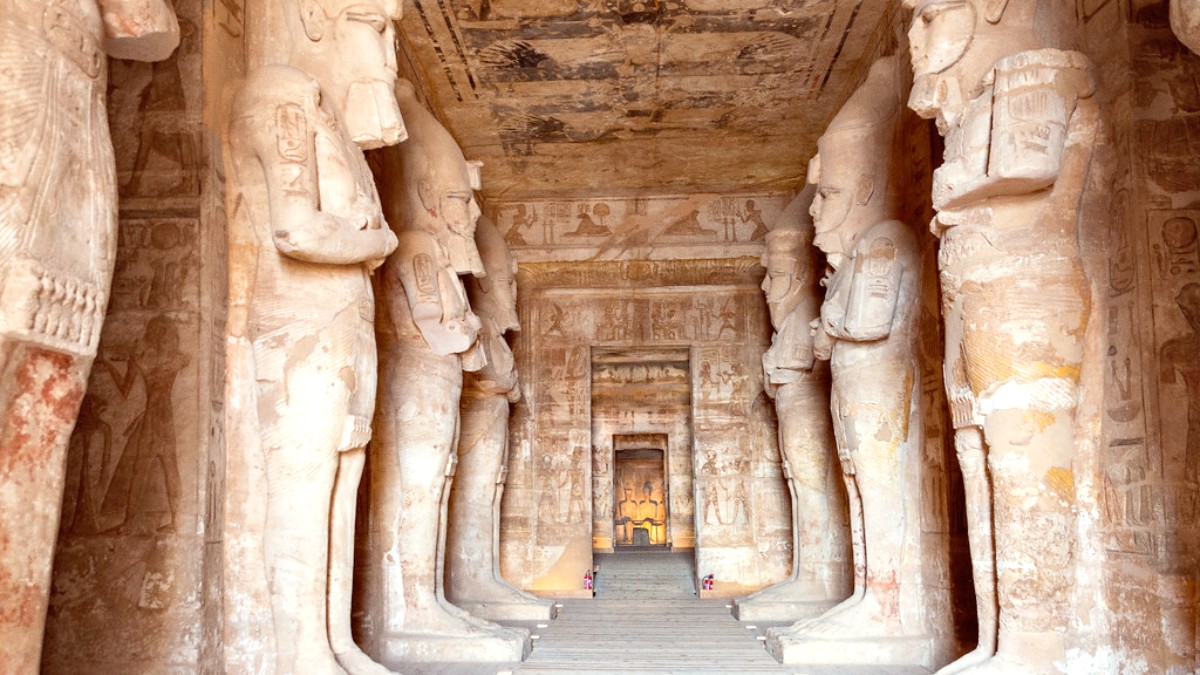
Egypt
The Abu Simbel temples, carved into the rock face in the 13th century BC, showcase Ramses II's immense power and devotion. The Great Temple is dedicated to Ramses II and three major deities, featuring four colossal statues of the pharaoh on its facade.
The Small Temple, dedicated to Hathor and Queen Nefertari, is noteworthy for depicting Nefertari as equal in height to Ramses II on its facade. These temples are a powerful statement of ancient Egyptian dominance in Nubia.
These temples represent a profound blend of artistry, engineering, and spiritual belief.
Arrive very early (6:00-7:00 AM) for fewer crowds and cooler temperatures. Sunrise light casts a warm glow, ideal for photography.
Purchase an interior photography ticket. Use a wide-angle lens for scale. Early morning light is best outside. Respect privacy; no photos of locals without permission. Explore Abu Simbel tours with photo opportunities.
Earliest morning (after 6:00 AM) and late afternoon (before closing) have fewer visitors than mid-morning. The low season (summer, June-August) also sees fewer tourists, but heat is a significant factor.
Held nightly after sunset, this spectacular presentation uses light projections and narration to share the history and significance of the temples. It offers a different, evocative way to experience the monuments.
While Abu Simbel's main draw are its temples, a small museum nearby provides additional context. Aswan, as the main base, has more cultural institutions.
An excellent museum in Aswan detailing Nubian history, culture, and art from prehistoric times to the present day. Houses artifacts rescued from areas flooded by Lake Nasser.
Features artifacts from Elephantine Island and the wider Aswan region, including mummies, tools, and pottery.
The village itself is small and mainly focused on temple tourism, with no other significant cultural institutions.
The Abu Simbel Temples are the main ancient historical sites in the immediate vicinity.
The Great Temple of Ramses II and the Small Temple of Hathor and Nefertari are the sole archaeological sites directly accessible to tourists in Abu Simbel.
These temples served as active religious sites during ancient Egyptian times, dedicated to major deities and the deified Pharaoh Ramses II. They were places of worship and offerings.
The entire complex serves as a profound monument to Ramses II and a memorial to the international effort that saved them from Lake Nasser's rising waters.
The village offers a glimpse into contemporary Nubian life, but it is not a historical district with ancient architecture in the traditional sense.
While not in Abu Simbel, the Aswan High Dam is a significant modern engineering feat whose construction led to the temples' relocation. Visits are often part of Aswan city tours.
In Aswan, explore the Unfinished Obelisk and Philae Temple, which also have strong historical ties to the region and ancient Egyptian stone craftsmanship.
The temples were built to display Ramses II's power and devotion, serving as powerful symbols of Egyptian dominance in Nubia.
They commemorate his victory at the Battle of Kadesh and his deification, reflecting ancient beliefs in divine pharaohs.
The temples are a testament to an unprecedented international effort by UNESCO to rescue them from flooding, preserving world heritage.
The natural environment around Abu Simbel centers on the vast Lake Nasser and the surrounding desert landscape.
This immense artificial lake, formed by the Aswan High Dam, stretches out behind the temples. It forms an impressive and often starkly beautiful backdrop. Witnessing sunrise or sunset over the lake with the temples in the foreground creates a memorable scenic view.
The journey to Abu Simbel involves traversing significant stretches of the Sahara Desert. The dramatic and stark beauty of this arid landscape, with its endless horizons and unique rock formations, offers its own quiet appeal.
The prominent sandstone cliffs, from which the Abu Simbel temples were originally carved, represent a remarkable geological feature. They offer insight into the raw material and the geological context of the region.
Limited opportunities for wildlife encounters in the immediate vicinity. Lake Nasser supports some birdlife, notably migratory species, which you may observe casually. Crocodiles exist but are very shy and rarely seen.
Lake Nasser is the dominant water body. It is not used for typical swimming or beach activities for tourists directly at Abu Simbel. Its purpose is mainly hydroelectric power and water storage. Some luxury Lake Nasser cruises offer swimming in designated areas.
No formal parks or gardens exist in Abu Simbel. The surrounding landscape consists of arid desert leading directly to the shores of Lake Nasser.
Beyond the main views, consider different vantage points for appreciating the temples' scale and setting.
While Lake Nasser is present, it is not generally for recreational swimming or typical beach activities at Abu Simbel's tourist areas.
Its main function is for hydroelectric power and water storage.
While Abu Simbel focuses on the main temples, exploring nearby areas, especially Aswan, reveals lesser-known delights.
Take time to explore the small Abu Simbel village itself, away from the immediate temple entrance. You can observe local Nubian life, perhaps find a local café, and get a feel for the community near this ancient wonder. It provides a contrast to the monumental temples.
Beyond direct views, consider exploring Aswan's hidden corners.
Seek out small, local eateries in Abu Simbel village or Aswan's less touristy areas. Ask your guide or hotel staff for advice on authentic, non-touristy food experiences.
A chance to connect with local culture through food.
Beyond standard Nile cruises, these offer access to lesser-visited temples and sites along the lake's shores that were also relocated during the High Dam construction.
A unique perspective on Nubian history and monumental rescue efforts.
Capture the temples in unique light and perspective.
Experiment with different angles from the approach path for best results.
Early morning visits to the temples avoid crowds and harsh sun.
Consider an Egyptologist guide for historical context.
Dedicate time to Aswan's cultural sites, like the Nubian Museum.
To fully appreciate the engineering feat of the temples' relocation, observe them from various angles, including a walk behind the main facades.